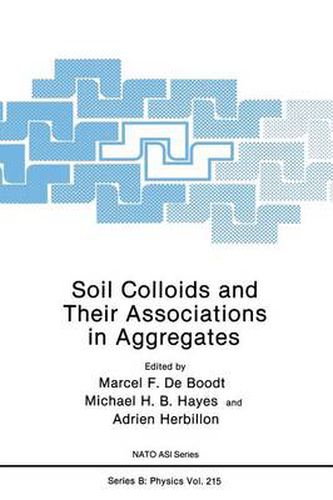Readings Newsletter
Become a Readings Member to make your shopping experience even easier.
Sign in or sign up for free!
You’re not far away from qualifying for FREE standard shipping within Australia
You’ve qualified for FREE standard shipping within Australia
The cart is loading…






This title is printed to order. This book may have been self-published. If so, we cannot guarantee the quality of the content. In the main most books will have gone through the editing process however some may not. We therefore suggest that you be aware of this before ordering this book. If in doubt check either the author or publisher’s details as we are unable to accept any returns unless they are faulty. Please contact us if you have any questions.
S. Henin Versailles, France It was a pleasure for me to take part in the NATO Advanced Study Workshop for studies of ‘Soil Colloids and their Associations in Soil Aggregates’. The meeting provided me with a welcome opportunity to renew acquaintances with respected colleagues in the various fields of Soil Science, to listen to their presentations, and be involved in discussions which were at the frontiers of the science which deals with the structures and the associations of the soil colloidal constituents. In my view the rapid advances in Soil Science, and the great benefits to agriculture from these, have their origins in the emerging understanding of the structures and the associations of the different soil colloids. It is clear that much research is still needed before the molecular details of the most important of the structures and of the interactions are fully understood. The associations between the soil colloids, and the manner in which they bind to or hold the other constituents of soils in aggregates is fundamental to soil fertility. and the Modem intensive agriculture leads to the degradation of soil structure subsequent loss through erosion of a resource that is vital for the production of food. This degradation is considered to result primarily from the biological oxidation of the indigenous soil organic matter, and from the failure to return to the soil sufficient organic residues to compensate for such losses.
$9.00 standard shipping within Australia
FREE standard shipping within Australia for orders over $100.00
Express & International shipping calculated at checkout
This title is printed to order. This book may have been self-published. If so, we cannot guarantee the quality of the content. In the main most books will have gone through the editing process however some may not. We therefore suggest that you be aware of this before ordering this book. If in doubt check either the author or publisher’s details as we are unable to accept any returns unless they are faulty. Please contact us if you have any questions.
S. Henin Versailles, France It was a pleasure for me to take part in the NATO Advanced Study Workshop for studies of ‘Soil Colloids and their Associations in Soil Aggregates’. The meeting provided me with a welcome opportunity to renew acquaintances with respected colleagues in the various fields of Soil Science, to listen to their presentations, and be involved in discussions which were at the frontiers of the science which deals with the structures and the associations of the soil colloidal constituents. In my view the rapid advances in Soil Science, and the great benefits to agriculture from these, have their origins in the emerging understanding of the structures and the associations of the different soil colloids. It is clear that much research is still needed before the molecular details of the most important of the structures and of the interactions are fully understood. The associations between the soil colloids, and the manner in which they bind to or hold the other constituents of soils in aggregates is fundamental to soil fertility. and the Modem intensive agriculture leads to the degradation of soil structure subsequent loss through erosion of a resource that is vital for the production of food. This degradation is considered to result primarily from the biological oxidation of the indigenous soil organic matter, and from the failure to return to the soil sufficient organic residues to compensate for such losses.